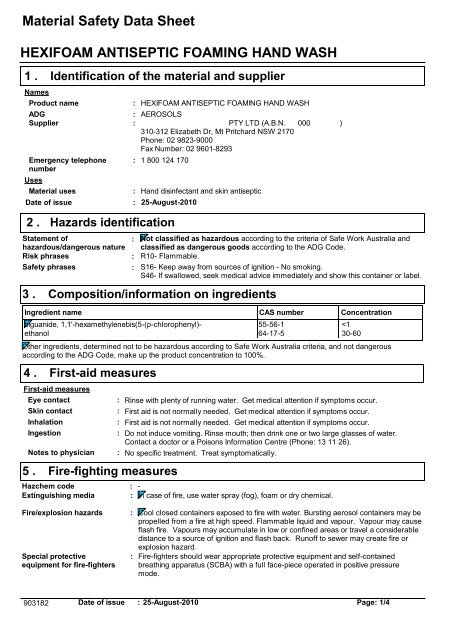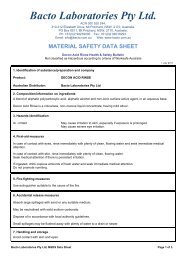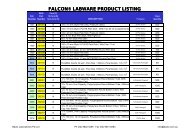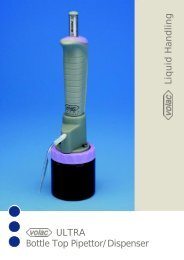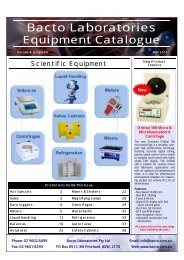Material Safety Data Sheet HEXIFOAM ANTISEPTIC FOAMING ...
Material Safety Data Sheet HEXIFOAM ANTISEPTIC FOAMING ...
Material Safety Data Sheet HEXIFOAM ANTISEPTIC FOAMING ...
You also want an ePaper? Increase the reach of your titles
YUMPU automatically turns print PDFs into web optimized ePapers that Google loves.
<strong>Material</strong> <strong>Safety</strong> <strong>Data</strong> <strong>Sheet</strong><br />
<strong>HEXIFOAM</strong> <strong>ANTISEPTIC</strong> <strong>FOAMING</strong> HAND WASH<br />
1 .<br />
Names<br />
Identification of the material and supplier<br />
Product name<br />
Emergency telephone<br />
number<br />
:<br />
<strong>HEXIFOAM</strong> <strong>ANTISEPTIC</strong> <strong>FOAMING</strong> HAND WASH<br />
ADG : AEROSOLS<br />
Supplier : PTY LTD (A.B.N. 000 )<br />
310-312 Elizabeth Dr, Mt Pritchard NSW 2170<br />
Phone: 02 9823-9000<br />
Fax Number: 02 9601-8293<br />
Uses<br />
:<br />
1 800 124 170<br />
<strong>Material</strong> uses : Hand disinfectant and skin antiseptic<br />
Date of issue<br />
2 .<br />
: 25-August-2010<br />
Hazards identification<br />
Statement of<br />
: Not classified as hazardous according to the criteria of Safe Work Australia and<br />
hazardous/dangerous nature classified as dangerous goods according to the ADG Code.<br />
Risk phrases : R10- Flammable.<br />
<strong>Safety</strong> phrases : S16- Keep away from sources of ignition - No smoking.<br />
S46- If swallowed, seek medical advice immediately and show this container or label.<br />
3 .<br />
Composition/information on ingredients<br />
Ingredient name CAS number Concentration<br />
biguanide, 1,1'-hexamethylenebis(5-(p-chlorophenyl)- 55-56-1
<strong>HEXIFOAM</strong> <strong>ANTISEPTIC</strong> <strong>FOAMING</strong> HAND WASH<br />
Hazardous decomposition<br />
products<br />
6 .<br />
Personal precautions<br />
Environmental precautions<br />
:<br />
Accidental release measures<br />
:<br />
:<br />
Decomposition products may include the following materials:<br />
carbon dioxide<br />
carbon monoxide<br />
nitrogen oxides<br />
halogenated compounds<br />
Immediately contact emergency personnel. Eliminate all ignition sources. Keep<br />
unnecessary personnel away. Use suitable protective equipment. Do not touch or<br />
walk through spilt material.<br />
Avoid dispersal of spilt material and runoff and contact with soil, waterways, drains<br />
and sewers. Inform the relevant authorities if the product has caused environmental<br />
pollution (sewers, waterways, soil or air).<br />
Methods for cleaning up : Stop leak if without risk. Move containers from spill area. Approach the release from<br />
upwind. Prevent entry into sewers, water courses, basements or confined areas.<br />
Wash spillages into an effluent treatment plant or proceed as follows. Contain and<br />
collect spillage with non-combustible, absorbent material e.g. sand, earth, vermiculite<br />
or diatomaceous earth and place in container for disposal according to local<br />
regulations (see section 13). Use spark-proof tools and explosion-proof equipment.<br />
Dispose of via a licensed waste disposal contractor. Contaminated absorbent<br />
material may pose the same hazard as the spilt product. Note: see section 1 for<br />
emergency contact information and section 13 for waste disposal.<br />
Note: see section 8 for personal protective equipment and section 13 for waste disposal.<br />
7 .<br />
Handling<br />
Storage<br />
8 .<br />
Handling and storage<br />
:<br />
:<br />
Put on appropriate personal protective equipment (see section 8). Eating, drinking<br />
and smoking should be prohibited in areas where this material is handled, stored and<br />
processed. Workers should wash hands and face before eating, drinking and<br />
smoking. Pressurised container: protect from sunlight and do not expose to<br />
temperature exceeding 50°C. Do not pierce or burn, even after use. Do not ingest.<br />
Avoid contact with eyes. Avoid breathing gas. Avoid breathing vapour or mist. Use<br />
only with adequate ventilation. Wear appropriate respirator when ventilation is<br />
inadequate. Store and use away from heat, sparks, open flame or any other ignition<br />
source. Use explosion-proof electrical (ventilating, lighting and material handling)<br />
equipment. Use non-sparking tools. Empty containers retain product residue and<br />
can be hazardous.<br />
Store in a segregated and approved area. Keep container in a cool, well-ventilated<br />
area. Keep container tightly closed and sealed until ready for use. Avoid all possible<br />
sources of ignition (spark or flame).<br />
Keep away from incompatibles, such as oxidizing material<br />
Engineering measures : No special ventilation requirements.<br />
Hygiene measures<br />
: Wash hands, forearms and face thoroughly after handling chemical products, before<br />
eating, smoking and using the lavatory and at the end of the working period.<br />
Appropriate techniques should be used to remove potentially contaminated clothing.<br />
Wash contaminated clothing before reusing. Ensure that eyewash stations and safety<br />
showers are close to the workstation location.<br />
Personal protection<br />
Eyes<br />
Hands<br />
Respiratory<br />
Exposure controls/personal protection<br />
Occupational exposure limits<br />
Ingredient name Exposure limits<br />
ethanol Safe Work Australia (Australia, 8/2005).<br />
TWA: 1880 mg/m³ 8 hour(s).<br />
TWA: 1000 ppm 8 hour(s).<br />
:<br />
:<br />
:<br />
No special protection is required.<br />
No special protection is required.<br />
903182 Date of issue :<br />
25-August-2010<br />
A respirator is not needed under normal and intended conditions of product use.<br />
Page: 2/4
<strong>HEXIFOAM</strong> <strong>ANTISEPTIC</strong> <strong>FOAMING</strong> HAND WASH<br />
Skin : No special protective clothing is required.<br />
9 .<br />
Physical state<br />
Colour<br />
Odour<br />
Boiling point<br />
Liquid. [Aerosol.]<br />
disinfectant<br />
<strong>HEXIFOAM</strong> <strong>ANTISEPTIC</strong> <strong>FOAMING</strong> HAND WASH<br />
13 .<br />
Disposal considerations<br />
Methods of disposal : Do not puncture or incinerate container. Do not reuse product container. The<br />
generation of waste should be avoided or minimised wherever possible. Avoid<br />
dispersal of spilt material and runoff and contact with soil, waterways, drains and<br />
sewers. Disposal of this product, solutions and any by-products should at all times<br />
comply with the requirements of environmental protection and waste disposal<br />
legislation and any regional local authority requirements. Dispose of via a licensed<br />
waste disposal contractor.<br />
14 .<br />
Transport information<br />
Regulation UN number Proper shipping name Class Packing<br />
group<br />
Additional information<br />
ADG UN1950 AEROSOLS 2.1 - Hazchem code<br />
-<br />
Initial emergency response<br />
guide<br />
G49<br />
IMDG 1950 AEROSOLS<br />
2.1 - Emergency schedules (EmS)<br />
F-D, S-U<br />
15 .<br />
Regulatory information<br />
Australia inventory (AICS) : All substances are listed on AICS or exempt.<br />
AU Classification : Not classified as hazardous according to the criteria of Safe Work Australia.<br />
Standard for the Uniform Scheduling of Drugs and Poisons<br />
Not scheduled<br />
R10- Flammable.<br />
Control of Scheduled Carcinogenic Substances<br />
Ingredient name Schedule<br />
No listed substance<br />
Product Registration Status : TGA<br />
16 .<br />
References :<br />
Disclaimer<br />
Other information<br />
Prepared by : Regulatory Affairs<br />
Date of previous issue : 06-October-2005<br />
Change Made : Update MSDS, include exposure standard, change pH and SG to range<br />
-ADG Code - Australian Transport of Dangerous Goods<br />
-Adopted National Exposure Standard for Atmospheric Contaminants in the Occupational Environment<br />
-Approved Criteria for Classifying Hazardous Substances<br />
-List of Designated Hazardous Substances<br />
-National Code of Practice for the Labelling of Workplace Substances<br />
-National Code of Practice for the Preparation of <strong>Material</strong> <strong>Safety</strong> <strong>Data</strong> <strong>Sheet</strong>s<br />
-National Model Regulations for the Control of Scheduled Carcinogenic Substances<br />
-National Model Regulations for the Control of Workplace Hazardous Substances<br />
-Standard for the Uniform Scheduling of Drugs and Poisons<br />
The above information is believed to be correct with respect to the formula used to manufacture the product in the country<br />
of origin. As data, standards, and regulations change, and conditions of use and handling are beyond our control, NO<br />
WARRANTY, EXPRESS OR IMPLIED, IS MADE AS TO THE COMPLETENESS OR CONTINUING ACCURACY OF THIS<br />
INFORMATION.<br />
903182 Date of issue :<br />
25-August-2010<br />
Page: 4/4


